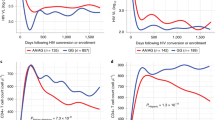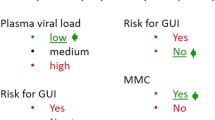Abstract
Several CC-motif chemokine ligands (CCLs) can block HIV-1-binding sites on CC-motif chemokine receptor 5 (CCR5) and inhibit viral entry. We studied single-nucleotide polymorphisms (SNPs) in genes encoding three CCR5 ligands (CCL3 (MIP-1α), CCL4 (MIP-1β) and CCL5 (RANTES)) along with an adjacent gene encoding a CCR2 ligand (CCL2 (MCP-1)) to identify candidate markers for HIV-1 infection and pathogenesis. Analyses of 567 HIV-1 serodiscordant Zambian couples revealed that rs5029410C (in CCL3 intron 3) was associated with lower viral load (VL) in seroconverters, adjusted for gender and age (regression β=−0.57 log10, P=4 × 10−6). In addition, rs34171309A in CCL3 exon 3 was associated with increased risk of HIV-1 acquisition in exposed seronegatives (hazard ratio=1.52, P=0.006 when adjusted for VL of the initially seropositive partner and genital ulcer/inflammation). SNP rs34171309 encodes a conservative Glu-to-Asp substitution. Five neighboring SNPs in tight linkage disequilibrium with rs34171309 all showed similar associations with HIV-1 acquisition. How these multiple CCL3 SNPs may alter the occurrence or course of HIV-1 infection remains to be determined.
This is a preview of subscription content, access via your institution
Access options
Subscribe to this journal
Receive 6 digital issues and online access to articles
$119.00 per year
only $19.83 per issue
Buy this article
- Purchase on Springer Link
- Instant access to full article PDF
Prices may be subject to local taxes which are calculated during checkout

Similar content being viewed by others
References
UNAIDS. AIDS Epidemic Update: December 2006. URL: http://data.unaids.org/pub/epireport/2006/2006_epiupdate_en.pdf.
Liu R, Paxton WA, Choe S, Ceradini D, Martin SR, Horuk R et al. Homozygous defect in HIV-1 coreceptor accounts for resistance of some multiply-exposed individuals to HIV-1 infection. Cell 1996; 86: 367–377.
Samson M, Libert F, Doranz BJ, Rucker J, Liesnard C, Farber CM et al. Resistance to HIV-1 infection in caucasian individuals bearing mutant alleles of the CCR-5 chemokine receptor gene. Nature 1996; 382: 722–725.
Dean M, Carrington M, Winkler C, Huttley GA, Smith MW, Allikmets R et al. Genetic restriction of HIV-1 infection and progression to AIDS by a deletion allele of the CKR5 structural gene. Hemophilia Growth and Development Study, Multicenter AIDS Cohort Study, Multicenter Hemophilia Cohort Study, San Francisco City Cohort, ALIVE Study. Science 1996; 273: 1856–1862.
Zimmerman PA, Buckler-White A, Alkhatib G, Spalding T, Kubofcik J, Combadiere C et al. Inherited resistance to HIV-1 conferred by an inactivating mutation in CC chemokine receptor 5: studies in populations with contrasting clinical phenotypes, defined racial background, and quantified risk. Mol Med 1997; 3: 23–36.
An P, Nelson GW, Wang L, Donfield S, Goedert JJ, Phair J et al. Modulating influence on HIV/AIDS by interacting RANTES gene variants. Proc Natl Acad Sci USA 2002; 99: 10002–10007.
Rathore A, Chatterjee A, Sivarama P, Yamamoto N, Singhal PK, Dhole TN . Association of RANTES -403 G/A, -28 C/G and In1.1 T/C polymorphism with HIV-1 transmission and progression among North Indians. J Med Virol 2008; 80: 1133–1141.
Menten P, Wuyts A, Van Damme J . Macrophage inflammatory protein-1. Cytokine Growth Factor Rev 2002; 13: 455–481.
Guan E, Wang J, Roderiquez G, Norcross MA . Natural truncation of the chemokine MIP-1 beta/CCL4 affects receptor specificity but not anti-HIV-1 activity. J Biol Chem 2002; 277: 32348–32352.
Cocchi F, DeVico AL, Garzino-Demo A, Arya SK, Gallo RC, Lusso P . Identification of RANTES, MIP-1 alpha, and MIP-1 beta as the major HIV-suppressive factors produced by CD8+ T cells. Science 1995; 270: 1811–1815.
Malhotra R, Hu L, Song W, Brill I, Mulenga J, Allen S et al. Association of chemokine receptor gene (CCR2-CCR5) haplotypes with acquisition and control of HIV-1 infection in Zambians. Retrovirology 2011; 8: 22.
Eugenin EA, Osiecki K, Lopez L, Goldstein H, Calderon TM, Berman JW . CCL2/monocyte chemoattractant protein-1 mediates enhanced transmigration of human immunodeficiency virus (HIV)-infected leukocytes across the blood-brain barrier: a potential mechanism of HIV-CNS invasion and NeuroAIDS. J Neurosci 2006; 26: 1098–1106.
Vilades C, Broch M, Plana M, Domingo P, Alonso-Villaverde C, Pedrol E et al. Effect of genetic variants of CCR2 and CCL2 on the natural history of HIV-1 infection: CCL2-2518GG is overrepresented in a cohort of Spanish HIV-1-infected subjects. J Acquir Immune Defic Syndr 2007; 44: 132–138.
Ansari AW, Bhatnagar N, Dittrich-Breiholz O, Kracht M, Schmidt RE, Heiken H . Host chemokine (C-C motif) ligand-2 (CCL2) is differentially regulated in HIV type 1 (HIV-1)-infected individuals. Int Immunol 2006; 18: 1443–1451.
Allen S, Meinzen-Derr J, Kautzman M, Zulu I, Trask S, Fideli U et al. Sexual behavior of HIV discordant couples after HIV counseling and testing. AIDS 2003; 17: 733–740.
Fideli US, Allen SA, Musonda R, Trask S, Hahn BH, Weiss H et al. Virologic and immunologic determinants of heterosexual transmission of human immunodeficiency virus type 1 in Africa. AIDS Res Hum Retroviruses 2001; 17: 901–910.
Royce RA, Sena A, Cates Jr W, Cohen MS . Sexual transmission of HIV. N Engl J Med 1997; 336: 1072–1078.
Ping LH, Nelson JA, Hoffman IF, Schock J, Lamers SL, Goodman M et al. Characterization of V3 sequence heterogeneity in subtype C human immunodeficiency virus type 1 isolates from Malawi: underrepresentation of X4 variants. J Virol 1999; 73: 6271–6281.
Gabriel S, Ziaugra L, Tabbaa D . SNP genotyping using the Sequenom MassARRAY iPLEX platform. Curr Protoc Hum Genet 2009; Chapter 2: Unit 2 12.
Barrett JC . Haploview: visualization and analysis of SNP genotype data. Cold Spring Harb Protoc 2009; 2009: pdb ip71.
Modi WS, Lautenberger J, An P, Scott K, Goedert JJ, Kirk GD et al. Genetic variation in the CCL18-CCL3-CCL4 chemokine gene cluster influences HIV type 1 transmission and AIDS disease progression. Am J Hum Genet 2006; 79: 120–128.
Modi WS, Goedert JJ, Strathdee S, Buchbinder S, Detels R, Donfield S et al. MCP-1-MCP-3-Eotaxin gene cluster influences HIV-1 transmission. AIDS 2003; 17: 2357–2365.
Gonzalez E, Rovin BH, Sen L, Cooke G, Dhanda R, Mummidi S et al. HIV-1 infection and AIDS dementia are influenced by a mutant MCP-1 allele linked to increased monocyte infiltration of tissues and MCP-1 levels. Proc Natl Acad Sci USA 2002; 99: 13795–13800.
McDermott DH, Beecroft MJ, Kleeberger CA, Al-Sharif FM, Ollier WE, Zimmerman PA et al. Chemokine RANTES promoter polymorphism affects risk of both HIV infection and disease progression in the Multicenter AIDS Cohort Study. AIDS 2000; 14: 2671–2678.
Yoshiura C, Kofuku Y, Ueda T, Mase Y, Yokogawa M, Osawa M et al. NMR analyses of the interaction between CCR5 and its ligand using functional reconstitution of CCR5 in lipid bilayers. J Am Chem Soc 2010; 132: 6768–6777.
Gonzalez E, Dhanda R, Bamshad M, Mummidi S, Geevarghese R, Catano G et al. Global survey of genetic variation in CCR5, RANTES, and MIP-1alpha: impact on the epidemiology of the HIV-1 pandemic. Proc Natl Acad Sci USA 2001; 98: 5199–5204.
Acknowledgements
We thank study participants, staff, interns and Project Management Group members of the Zambia-Emory HIV-1 Research Project in Lusaka, Zambia; technical staff and students at the virology laboratory at the University Teaching Hospital, Lusaka, the immunogenetics laboratory and the data analysis group in the Program in Epidemiology of Infection and Immunity at UAB School of Public Health. This study was supported primarily by the US National Institute of Allergy and Infectious Diseases, through Grants AI041951 and AI071906 to RAK, AI040951 to SA, AI064060 to EH and AI076123 to JT.
Author information
Authors and Affiliations
Corresponding author
Ethics declarations
Competing interests
The authors declare no conflict of interest.
Additional information
Supplementary Information accompanies the paper on Genes and Immunity website
Supplementary information
Rights and permissions
About this article
Cite this article
Hu, L., Song, W., Brill, I. et al. Genetic variations and heterosexual HIV-1 infection: analysis of clustered genes encoding CC-motif chemokine ligands. Genes Immun 13, 202–205 (2012). https://doi.org/10.1038/gene.2011.70
Received:
Revised:
Accepted:
Published:
Issue Date:
DOI: https://doi.org/10.1038/gene.2011.70



